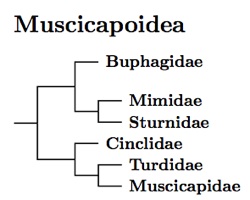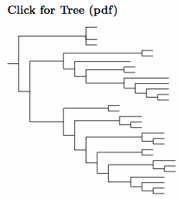Muscicapoidae
 The use of an expanded Muscicapoidea means that the former superfamily
Muscicapoidea has been demoted to the epifamily Muscicapoidae. It too grows
slightly, gaining the monotypic Elachuridae. Elachuridae takes the basal
position in the epifamily Muscicapoidae. See Oliveros et
al. (2019) and Stiller et al. (2024). Elachuridae was
not included in Kuhl et al.'s (2021) analysis.
The use of an expanded Muscicapoidea means that the former superfamily
Muscicapoidea has been demoted to the epifamily Muscicapoidae. It too grows
slightly, gaining the monotypic Elachuridae. Elachuridae takes the basal
position in the epifamily Muscicapoidae. See Oliveros et
al. (2019) and Stiller et al. (2024). Elachuridae was
not included in Kuhl et al.'s (2021) analysis.
After Elachura, Muscicapoidae breaks into two clades. The first contains the oxpeckers, mockingbirds, and starlings (Muscicapoidae I). The other contains the dippers, thrushes, and Old World flycatchers (Muscicapoidae II).
Elachuridae: Spotted Elachura Alström et al., 2014
1 genus, 1 species Not HBW Family
I had previously speculated that Elachura, often classified in Spelaeornis, was not a babbler, but possibly related to Pnoepyga. I was half-right and half-wrong. It's not a babbler, but somewhat related to waxwings (Alström et al., 2014). I had also speculated that two other Spelaeornis may belong with Elachura. Alström et al. showed that those two are true Spelaeornis.
- Spotted Elachura / Spotted Wren-babbler, Elachura formosa
Oxpeckers, Mockingbirds, and Starlings
 |
| Click for Muscicapoidea genera, part I |
|---|
The Buphagidae (oxpeckers) must be given their own family to avoid merging the Sturnidae and Mimidae. The Philippine creepers (Rhabdornis) have variously been considered a separate family (Howard and Moore, 2003), part of Certhiidae (Sharpe, 1903; Beecher, 1953), or members of Sylviidae (Sibley and Monroe, 1993), but they actually are embedded within the Sturnidae (Zuccon et al., 2006; Lovette and Rubenstein, 2007). They are basal members of a clade of south Asian and Pacific Starlings, which includes the hill-mynas.
Buphagidae: Oxpeckers Lesson, 1828
1 genus, 2 species HBW-14
- Red-billed Oxpecker, Buphagus erythrorynchus
- Yellow-billed Oxpecker, Buphagus africanus
Mimidae: Mockingbirds, Thrashers Bonaparte, 1853
10 genera, 35 species HBW-10
 |
| Click for Buphagidae and Mimidae tree |
|---|
The Mimidae seem fairly stable in terms of membership, but have undergone some rearrangement. The taxonomy is based on Lovette et al. (2012). It is little changed from a previous version primarily based on Lovette and Rubenstein (2007), where Arbogast et al. (2006), Hunt et al. (2001), and Zink et al. (1999) were also consulted. There are two main clades, one including the catbirds through tremblers, the other consisting of mockingbirds and thrashers.
The genera Mimodes and Nesomimus have been folded into Mimus (see Arbogast et al., 2006; Barber et al., 2004) and Allenia has been split from Margarops (Hunt et al., 2001).
The genetics of the Northern and Tropical Mockingbirds are complex, and the complex deserves further study to sort out the situation. The Galapagos complex also deserves further study. Arbogast et al. (2006) found that the Genovesan race of Galapagos Mockingbird (bauri) appeared to be more closely related to the San Cristobal Mockingbird than to the other races of Galapagos Mockingbird.
White-breasted Thrasher Split: The White-breasted Thrasher, Ramphocinclus brachyurus, has been split into Martinique Thrasher, Ramphocinclus brachyurus, and St. Lucia Thrasher, Ramphocinclus sanctaeluciae. For more, see DaCosta et al. (2019) and AOS Proposal 2024-C-8 (the proposal starts on page 62).
- Blue Mockingbird, Melanotis caerulescens
- Blue-and-white Mockingbird, Melanotis hypoleucus
- Black Catbird, Melanoptila glabrirostris
- Gray Catbird, Dumetella carolinensis
- Martinique Thrasher, Ramphocinclus brachyurus
- St. Lucia Thrasher, Ramphocinclus sanctaeluciae
- Scaly-breasted Thrasher, Allenia fusca
- Pearly-eyed Thrasher, Margarops fuscatus
- Brown Trembler, Cinclocerthia ruficauda
- Gray Trembler, Cinclocerthia gutturalis
- Curve-billed Thrasher, Toxostoma curvirostre
- Ocellated Thrasher, Toxostoma ocellatum
- Brown Thrasher, Toxostoma rufum
- Long-billed Thrasher, Toxostoma longirostre
- Cozumel Thrasher, Toxostoma guttatum
- Bendire's Thrasher, Toxostoma bendirei
- Gray Thrasher, Toxostoma cinereum
- California Thrasher, Toxostoma redivivum
- Le Conte's Thrasher, Toxostoma lecontei
- Crissal Thrasher, Toxostoma crissale
- Sage Thrasher, Oreoscoptes montanus
- Chilean Mockingbird, Mimus thenca
- Patagonian Mockingbird, Mimus patagonicus
- Chalk-browed Mockingbird, Mimus saturninus
- White-banded Mockingbird, Mimus triurus
- Brown-backed Mockingbird, Mimus dorsalis
- Long-tailed Mockingbird, Mimus longicaudatus
- Socorro Mockingbird, Mimus graysoni
- Northern Mockingbird, Mimus polyglottos
- Tropical Mockingbird, Mimus gilvus
- Bahama Mockingbird, Mimus gundlachii
- Galapagos Mockingbird, Mimus parvulus
- Floreana Mockingbird, Mimus trifasciatus
- San Cristobal Mockingbird, Mimus melanotis
- Espanola Mockingbird, Mimus macdonaldi
Sturnidae: Starlings, Mynas Rafinesque, 1815
35 genera, 122 species HBW-14
The Philippine creepers (Rhabdornis) were thought to be babblers, but Barker et al. (2004) and Cibois and Cracraft (2004) found they were allied to the starlings. This led to thoughts they should be a separate family, but more recently Zuccon et al. (2006) and Lovette and Rubenstein (2007) found they were embedded in the Sturnidae.
The taxonomy here mainly follows the extensive analysis of Lovette and Rubenstein (2007), with help from Lovette et al. (2008) and Zuccon et al. 2006. Lovette and Rubenstein identified a number of major clades. The subfamily Graculinae includes the starlings and mynas of south Asia and the Pacific. It includes two tribes, the Philippine creepers (Rhabdornithini) and the south Asian/Pacific starlings and mynas (Graculini). The second subfamily, Sturninae, includes the Eurasian and African starlings. It includes 4 tribes: the Eurasian starlings and mynas (Sturnini), the Amethyst and Madagascan starlings (Cinnyricinclini), the red-winged starlings (Onychognathini), and the African starlings (Lamprotornini).
Lovette et al. (2008) provides a complete genetic analysis of all of the extant Eurasian starlings and mynas (Sturnini). The genus Sturnus was found to be overly broad, resulting in splits of Pastor, Gracupica, Agropsar, Sturnornis, Sturnia (aka Temenuchus), and Spodiopsar (Poliopsar). Also, S. burmannicus has been moved to Acridotheres. The recent paper by Zuccon et al. (2008) slightly refines the ordering (mainly the Hoopoe Starling), and corrects two of the genus names (to Sturnia and Spodiopsar). The extinct Reunion Starling has not been sequenced, but is believed to be sister to the Hoopoe Starling.
Other generic changes include splitting Hartlaubius from Saroglossa, and both Notopholia and Hylopsar from Lamprotornis. In the other direction, Spreo has been merged into Lamprotornis. Finally, Poeoptera femoralis has moved from Cinnyricinclus.
Graculinae: South Asian/Pacific Starlings G.R. Gray, 1841 (1831)
Rhabdornithini: Philippine Creeper Greenway, 1967
- Stripe-headed Rhabdornis, Rhabdornis mystacalis

Click for Sturnidae
tree, part I - Grand Rhabdornis, Rhabdornis grandis
- Stripe-breasted Rhabdornis, Rhabdornis inornatus
Graculini: South Asian & Pacific Starlings and Mynas G.R. Gray, 1841 (1831)
- Sulawesi Myna, Basilornis celebensis
- Helmeted Myna, Basilornis galeatus
- Long-crested Myna, Basilornis corythaix
- Apo Myna, Goodfellowia miranda
- Coleto, Sarcops calvus
- White-necked Myna, Streptocitta albicollis
- Bare-eyed Myna, Streptocitta albertinae
- Yellow-faced Myna, Mino dumontii
- Long-tailed Myna, Mino kreffti
- Golden Myna, Mino anais
- Golden-crested Myna, Ampeliceps coronatus
- Sri Lanka Hill-Myna, Gracula ptilogenys
- Common Hill-Myna, Gracula religiosa
- Southern Hill-Myna, Gracula indica
- Nias Hill-Myna, Gracula robusta
- Enggano Hill-Myna, Gracula enganensis
- Fiery-browed Starling, Enodes erythrophris
- Grosbeak Starling, Scissirostrum dubium
- White-eyed Starling, Aplonis brunneicapillus
- Yellow-eyed Starling, Aplonis mystacea
- Metallic Starling, Aplonis metallica
- Long-tailed Starling, Aplonis magna
- Pohnpei Starling, Aplonis pelzelni
- Kosrae Starling, Aplonis corvina
- Micronesian Starling, Aplonis opaca
- Brown-winged Starling, Aplonis grandis
- Makira Starling, Aplonis dichroa
- Singing Starling, Aplonis cantoroides
- Tanimbar Starling, Aplonis crassa
- Asian Glossy Starling, Aplonis panayensis
- Moluccan Starling, Aplonis mysolensis
- Short-tailed Starling, Aplonis minor
- Atoll Starling, Aplonis feadensis
- Rennell Starling, Aplonis insularis
- Rusty-winged Starling, Aplonis zelandica
- Striated Starling, Aplonis striata
- Mountain Starling, Aplonis santovestris
- Polynesian Starling, Aplonis tabuensis
- Samoan Starling, Aplonis atrifusca
- Rarotonga Starling, Aplonis cinerascens
- Mauke Starling, Aplonis mavornata
- Tasman Starling, Aplonis fusca
Sturninae: African/Eurasian Starlings Rafinesque, 1815
Sturnini: Eurasian Starlings Rafinesque, 1815
- European Starling / Common Starling, Sturnus vulgaris

Click for Sturnidae
tree, part II - Spotless Starling, Sturnus unicolor
- Wattled Starling, Creatophora cinerea
- Rosy Starling, Pastor roseus
- Black-collared Starling, Gracupica nigricollis
- Pied Myna, Gracupica contra
- Daurian Starling, Agropsar sturninus
- Chestnut-cheeked Starling, Agropsar philippensis
- White-faced Starling, Sturnornis albofrontatus
- Bali Myna, Leucopsar rothschildi
- Hoopoe Starling, Fregilupus varius
- Rodrigues Starling, Necropsar rodericanus
- White-shouldered Starling, Sturnia sinensis
- Brahminy Starling, Sturnia pagodarum
- White-headed Starling, Sturnia erythropygia
- Chestnut-tailed Starling, Sturnia malabarica
- Malabar Starling, Sturnia blythii
- Red-billed Starling, Spodiopsar sericeus
- White-cheeked Starling, Spodiopsar cineraceus
- Bank Myna, Acridotheres ginginianus
- Common Myna, Acridotheres tristis
- Black-winged Starling, Acridotheres melanopterus
- Vinous-breasted Starling, Acridotheres burmannicus
- Collared Myna, Acridotheres albocinctus
- Great Myna, Acridotheres grandis
- Crested Myna, Acridotheres cristatellus
- Jungle Myna, Acridotheres fuscus
- Javan Myna, Acridotheres javanicus
- Pale-bellied Myna, Acridotheres cinereus
Cinnyricinclini: Madagascan and Violet-backed Starling Informal
- Madagascan Starling, Hartlaubius auratus

Click for Sturnidae
tree, part III - Violet-backed Starling, Cinnyricinclus leucogaster
Onychognathini: Red-winged Starlings Bonaparte, 1854
- Slender-billed Starling, Onychognathus tenuirostris
- Pale-winged Starling, Onychognathus nabouroup
- Red-winged Starling, Onychognathus morio
- Neumann's Starling, Onychognathus neumanni
- Chestnut-winged Starling, Onychognathus fulgidus
- Waller's Starling, Onychognathus walleri
- Tristram's Starling, Onychognathus tristramii
- White-billed Starling, Onychognathus albirostris
- Bristle-crowned Starling, Onychognathus salvadorii
- Somali Starling, Onychognathus blythii
- Socotra Starling, Onychognathus frater
Lamprotornini: African Starlings Swainson, 1831
- Black-bellied Starling, Notopholia corusca
- Purple-headed Starling, Hylopsar purpureiceps
- Copper-tailed Starling, Hylopsar cupreocauda
- Spot-winged Starling, Saroglossa spiloptera
- Babbling Starling, Neocichla gutturalis
- White-collared Starling, Grafisia torquata
- Magpie Starling, Speculipastor bicolor
- Sharpe's Starling, Pholia sharpii
- Abbott's Starling, Poeoptera femoralis
- Narrow-tailed Starling, Poeoptera lugubris
- Stuhlmann's Starling, Poeoptera stuhlmanni
- Kenrick's Starling, Poeoptera kenricki
- Hildebrandt's Starling, Lamprotornis hildebrandti
- Shelley's Starling, Lamprotornis shelleyi
- Burchell's Starling, Lamprotornis australis
- Rueppell's Starling, Lamprotornis purpuroptera
- Long-tailed Glossy Starling, Lamprotornis caudatus
- Meves's Starling, Lamprotornis mevesii
- Ashy Starling, Lamprotornis unicolor
- Lesser Blue-eared Starling, Lamprotornis chloropterus
- Miombo Blue-eared Starling, Lamprotornis elisabeth
- Sharp-tailed Starling, Lamprotornis acuticaudus
- Greater Blue-eared Starling, Lamprotornis chalybaeus
- Emerald Starling, Lamprotornis iris
- Purple Starling, Lamprotornis purpureus
- Cape Starling, Lamprotornis nitens
- Bronze-tailed Starling, Lamprotornis chalcurus
- Splendid Starling, Lamprotornis splendidus
- Principe Starling, Lamprotornis ornatus
- Golden-breasted Starling, Lamprotornis regius
- Superb Starling, Lamprotornis superbus
- Chestnut-bellied Starling, Lamprotornis pulcher
- Pied Starling, Lamprotornis bicolor
- Fischer's Starling, Lamprotornis fischeri
- White-crowned Starling, Lamprotornis albicapillus